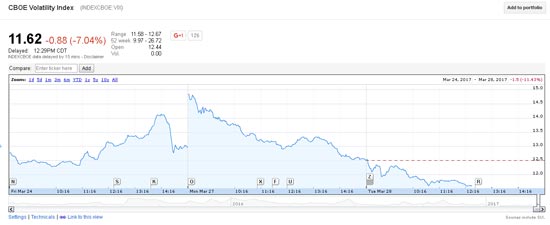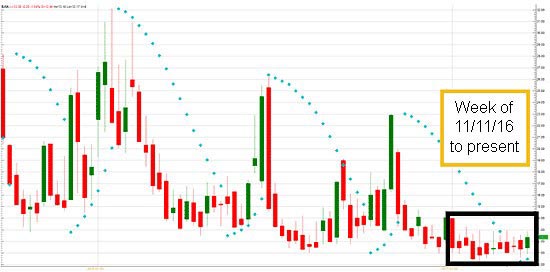 The House GOP's healthcare bill died in Congress last Friday (March 24). The legislation didn't even make it to the floor for a vote.
The House GOP's healthcare bill died in Congress last Friday (March 24). The legislation didn't even make it to the floor for a vote.
Because the bill was pulled at 4 p.m. (after the closing bell), market emotion surrounding the plan's demise didn't surface until the following Monday morning.
Once markets had an opportunity to react, boy did they ever...
All but one of the Dow Industrials slipped early Monday, with five components falling more than 1%. Dow futures tumbled as much as 184 points pre-market. (Later in the day, the DJIA managed to pare its losses to 46 points down at the closing bell; still, it was the index's eighth day in a losing streak not seen since 2011.)
Overall, the DJIA's plunge was summarily viewed by Wall Street pundits as a reflection of rising concerns that President Donald Trump's bold campaign promises were now in doubt.
For example, analysts at Rabobank wrote in a report to investors on Monday that "global financial markets are in a risk off mode after the political spectacle that unfolded last week on Capitol Hill."
And Peter Cardillo, chief market economist at First Standard Financial, told CNBC Monday that he doesn't "think this is the beginning of a full-blown correction, but it's definitely a reversal in market sentiment."
Must See: For only the third time in 20 years, a metal more rare and more exotic than gold is about to make stock market history. And it's poised to make early investors a lot of money. Read more...
But these talking heads are misleading investors with their analyses - whether accidental or not...
You see, they aren't reporting a full account of market sentiment, primarily because they're looking to one particular source as evidence...

Using the VIX (aka the Chicago Board Options Exchange [CBOE] Volatility Index, also known as the "fear index") as a sole gauge of market sentiment is a problem. While it was created to measure investor sentiment in the markets, the VIX fails to accurately convey market emotions in real time.
This means the VIX's inaccurate data poses a huge problem for a large number of investors...
Free Profit-Making Report: The Secret That Can Turn $2,500 into $1 Million or More
Investors trading options -- which make up over a quarter of the trades (36.5%, or 3.9 million trades, according to Nasdaq.com on March 28) on the CBOE -- are being misled by pundits who tout the fear index's latest moves as real-time representations of Wall Street emotions, according to Money Morning Options Trading Specialist Tom Gentile, one of the world's foremost authorities on futures and options trading.
The statistical imprecision -- a sort of "delay effect" on the VIX's part -- is particularly dangerous for option traders.
After all, they're the investors looking to open positions in the near term based on accurately supported, anticipated market sentiment...
Why VIX's "Market Emotion" Does Nothing for Option Traders
Gentile says "the VIX is not the best way to gauge the amount of fear in the markets." He offers the index's current data as his incontrovertible (and rather alarming) proof...
[mmpazkzone name="in-story" network="9794" site="307044" id="137008" type="4"]
Take yesterday (March 28), for example.
The VIX was low -- at 11.62. And "low" is quantified in the VIX as any number below its (hotly debated) median of 17.1.
A lower VIX average reflects fewer negative emotions driving the financial markets. A higher VIX average, conversely, indicates that investors are worried and are, perhaps, expecting some sort of bearish outcome in the near future (the VIX predicts market emotion for the next 30 days).
But Gentile points to the index's tendency to remain "low" as a problem. "VIX can go low," he says, "and stay there for quite a while, which doesn't really make it a useful market timing tool. The VIX has been under 15 for some time [while] the markets have catapulted to all-time highs (until the recent 1% pullback in the markets this week)."
Gentile uses a November 2016 VIX weekly chart to support this claim...
"[In the chart] you can see that the VIX has been under 15 in 32 of those 78 weeks. And when looking at a shorter-term view, say from Nov. 11, 2016, following Donald Trump's win to now - it hasn't gone above 15 once, while the markets [meanwhile] have hit historical new highs..."

This means that those analyzing the VIX's comprehensive behavior of late (ahem, pundits) could easily be misled to think - and likewise report - that there is little emotion driving the markets.
But again, the Dow's performance on Monday, as well as the seven business days that led up to it, says otherwise.
And to this point, Gentile offers investors a better source for gauging market emotions in lieu of the unreliable VIX...
Forget the VIX - Look at a Stock's "Implied Volatility" Instead
Implied volatility is the anticipated volatility of a stock (or other security).
"Generally speaking," Gentile says, "[the VIX] increases in bearish markets and decreases in bullish markets."
Traders - and options buyers in particular - want low implied volatility when they open their positions with the anticipation that it will increase over time.
"In the case of an option trade," writes Gentile, "when implied volatility increases over time, it also increases the option's premium faster and by a larger amount so that the trade can be closed for a nice profit."
And when you don't consider a stock's implied volatility closely...
"You run the risk of buying-to-open an option in which the implied volatility is already too high, making it challenging for that premium to increase. And that means it's harder for you to cash in on the trade," Gentile says.
So when it comes to options and maximizing your profits, Gentile recommends taking the media talking heads' analysis of market emotion with a grain of salt. Look at a security's implied volatility instead. "The CBOE offers a free service, the 'IV Index,' which you can use to track the implied volatility of calls and puts as well as their historical volatility and correlation against major indices," Gentile adds.
That's a better tool for options traders to use.
Follow Tom on Facebook and Twitter.
Up Next:


